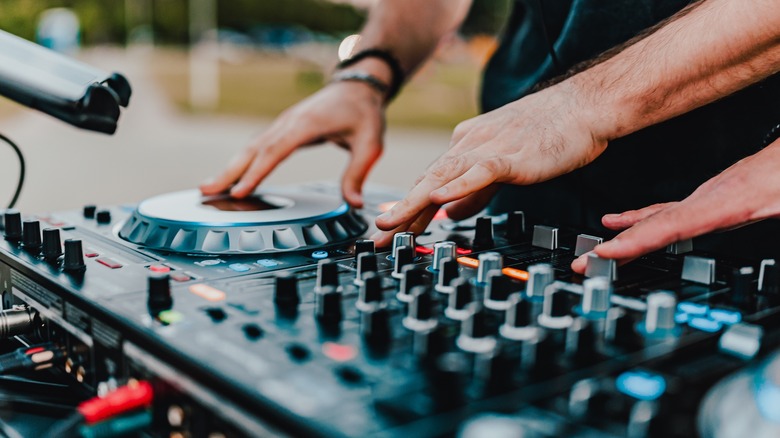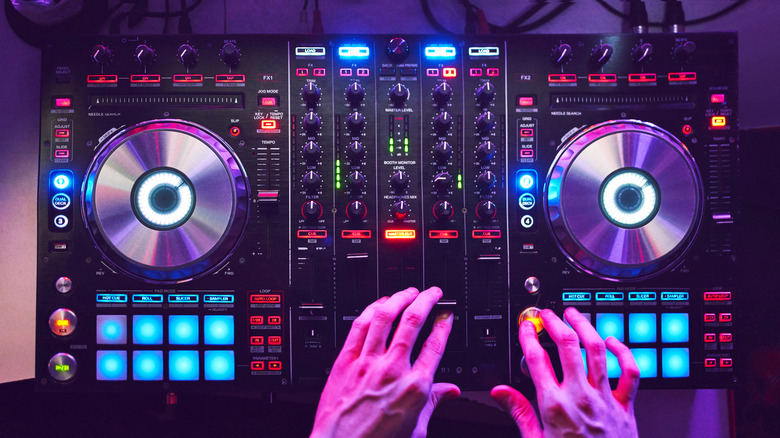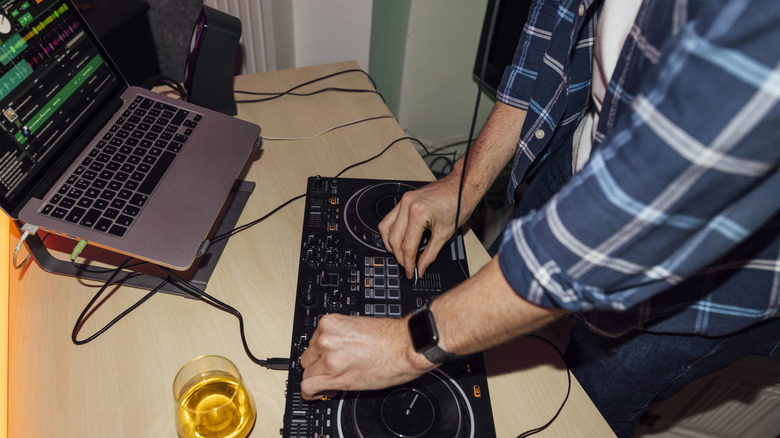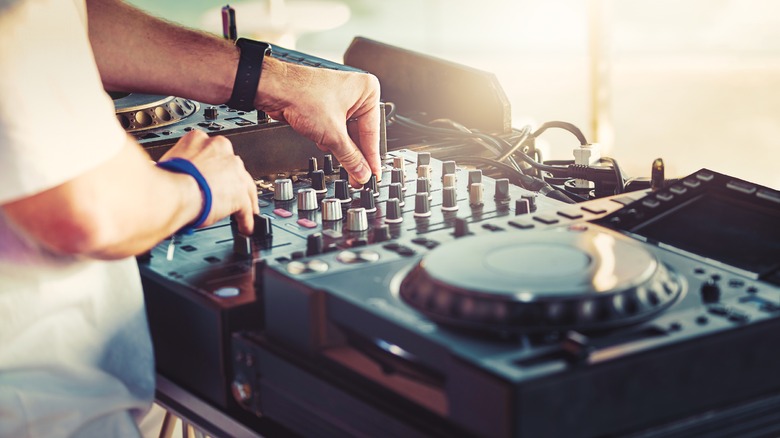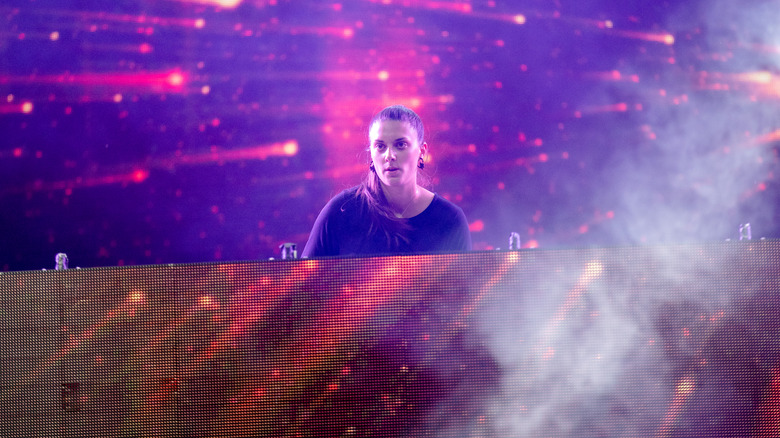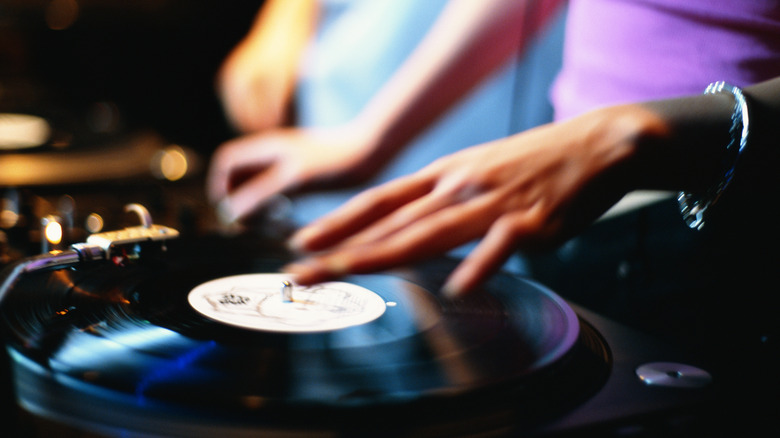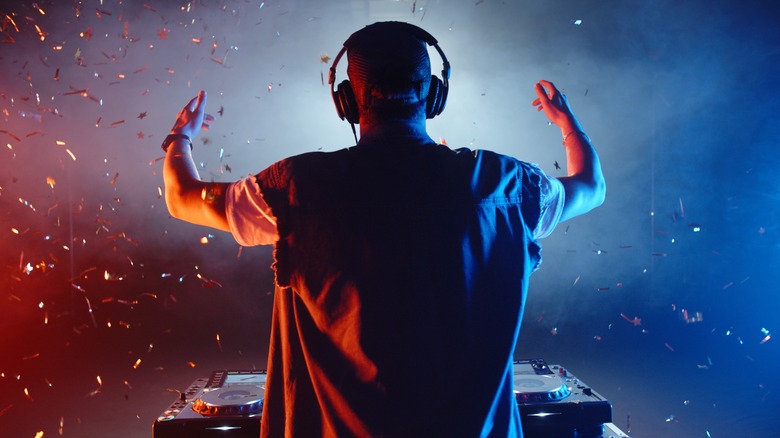How To Build Your First DJ Deck: A Beginner's Guide
Have you caught the DJ bug? Symptoms include spending more time checking out the DJ's equipment than you do dancing when you go out to clubs. Maybe you envision yourself in that booth, mixing, spinning, and hyping up the crowd. If so, you're going to need to stock up on gear.
Your dad isn't the only one who can build a deck. If you plan on tearing up dance floors and eventually making it to the main stage of EDC, you'll need to build a deck of your own: a DJ deck, that is. Building your first DJ setup can seem daunting. There's so much terminology, so many different kinds of hardware and software, that it's easy to give up before you've even started. There's also a lot of overpriced audio tech that you're better off staying away from. But once you understand what you're looking for, you can focus on what matters, which is playing your favorite music to bring parties, raves, and club dance floors to life.
In this guide, we'll explore the different kinds of equipment and software DJ decks are comprised of, along with what you should keep in mind when shopping. From controllers to CDJs and Traktor to Serato, this is a beginner's guide to building your first DJ deck.
Standalone DJ controllers are a good starting point
If you're interested in DJing, chances are you've seen a controller before. They're desk-sized slabs of hardware with two big wheels and a whole lot of buttons, knobs, and sliders. Predictably, a controller controls a piece of software on your computer, usually DJ software or a DAW (digital audio workstation). The most prominent controller manufacturers include Pioneer, Native Instruments, and Numark, with the former two brands being the most generally well regarded by performing DJs and the latter specializing in budget controllers. Other well-regarded brands include Roland, Rane, and Denon.
Controllers are the bedrock of any DJ's deck, but there are several considerations you should make when choosing one. First, ensure that your controller is compatible with your DJ software (we'll talk more about software later). Second, make sure your controller has the functionality you need for your mixing style, such as performance pads, multi-channel mixer, beat sync, loopers, samplers, and effects. And of course, consider your budget. While there are some DJ controllers available for under $100, high-end controllers can easily cost multiple thousands of dollars. It may be tempting to buy cheap, but budget boards tend to lack features you'll need if you plan on playing live shows, so consider what your needs may be later down the road. If you're just dipping your toes in the DJ water, though, it could be better to buy a cheap controller for beginners rather than sink a whole paycheck into something that ends up collecting dust. Lastly, while some DJ controllers are made to be used with software on a laptop, others are all-in-one systems that let you plug in a flash drive or stream from online music repositories, so consider how integral your computer is to your workflow.
Don't forget about DJ software
Choosing your DJ software is arguably the most important decision a novice DJ will make. For many setups, your laptop and mixing software will act as the brains of the deck. (Those in need of a computer can check out our best laptops for music production.) The most popular DJ software includes Traktor, Serato, Rekordbox, and Virtual DJ, among others. All of them work by emulating a turntable setup on your computer, which can then be controlled with (surprise) a controller.
Your primary concern when choosing DJ software should be whether it's compatible with your hardware. Both Traktor and Rekordbox are made by prominent DJ hardware companies — Native Instruments and Pioneer, respectively — so they can be virtually guaranteed to work with hardware made by those manufacturers. Your controller's documentation should specify whether it works best with any particular software, and the software's documentation should note which hardware models it supports.
Next, you should look at the features each program offers. Rekordbox, for example, offers a cloud library sync feature which allows users to sync their music library, including cue points, across up to eight devices, including a mobile app. Traktor, meanwhile, offers deep physical integration with Native Instruments controllers, including haptic feedback.
Some DJs opt for a live setup, meaning they record or play back individual elements of a song in real time instead of playing entire, pre-recorded songs. For these artists, Ableton Live is often their software of choice. It's a full audio production suite and DAW that's built around the ability for live performances and works on Mac and Windows. For Mac users, another great live option is Mainstage, which works with Logic Pro to create a live performance environment.
Modular DJ decks
When performing at large events such as festivals, you'll see most DJs use a modular setup consisting of two or more turntables and a mixer. In this context, modular simply means that the setup is composed of multiple pieces of gear rather than a single, unified board containing both turntables and mixing controls.
The central component of a modular setup will usually be a mixer, which routes the audio being played and can add effects. Popular mixers include the Native Instruments Traktor Kontrol X1 and many mixers made by Pioneer, such as the DJ DJM-A9. It is possible to create a setup without a dedicated mixer, depending on how central your laptop is to the deck, but for standalone setups, one will be necessary. The other component of a professional modular DJ deck are CDJs, which have big jog wheels to emulate turntables, along with other controls for looping, effects, and more.
Modular CDJ setups, however, are usually prohibitively expensive for beginners, and prices for a full setup with two CDJs and a mixer can easily cost multiple thousands of dollars. That's why you generally don't see these decks outside of massive festivals, popular nightclubs, and other professional settings.
Samplers, sequencers, and synthesizers, oh my!
Beyond controllers and CDJs, there are a nearly limitless number of other devices that can be slotted into your DJ deck. You can round your kit out with samplers, sequencers, MIDI controllers, or a whole slew of other devices. These bits of hardware come in every shape and size, so it wouldn't be possible to cover them all here, but we can look at an example.
To illustrate how a setup without a conventional turntable controller works in practice, take a look at this video, which shows a live-streamed set from popular bass musician CloZee. She's using an unconventional DJ deck setup comprised of a MacBook running Ableton Live and controlled by an Akai APC40, which is a specialized controller for triggering live clips in Ableton, along with a Native Instruments Maschine, which is most likely being used to sequence drums and other rhythmic patterns. The benefit of this setup is that it allows CloZee to trigger various elements in her songs individually, giving her far more granular control over the mix.
For your own setup, feel free to experiment with any piece of gear you think might unlock new modes of creativity. You might fancy a classic piece of gear like the Akai MPC One Retro, or something more futuristic like the ROLI Seaboard RISE 2. The truth is, DJing is more art than science, and the more you explore different tools, the more you'll figure out what works with your style.
Vinyl or digital?
Depending on the type of DJ you plan to become, you'll face a fork in the road when choosing your turntables. The practice of DJing began when artists took classic vinyl record turntables and used them in a way that was unintended by the manufacturer, manipulating the records to create scratches and breaks. Today's vinyl DJ turntables use the same concept, but are purpose-built for that sort of manipulation. Since you're working with analog records, vinyl DJing requires much more training and skill. Today, while it still has a place in DJ culture, vinyl is rarely seen outside of hip-hop shows, DJ competitions, and other more eclectic contexts.
In the era of EDM music, vinyl has become much more of a niche than it once was. The dominance of electronic production precipitated the rise of digital DJ equipment. In a digital paradigm, all the music is stored on a computer or flash drive. Specialized DJ software maps out the BPM (beats per minute) of each song, while identifying possible mix and break points. Not only is digital DJing much easier to master than vinyl, but it allows for a lot more creativity when mixing between songs. The equipment we've talked about in this guide, such as controllers, CDJs, and other gear, is all digital.
In short, while old-school fans of the craft will appreciate someone who has skill on a real turntable, vinyl has become relegated to its own category, and most aspiring DJs are better off mastering the more versatile digital equipment.
Headphones will keep you in the mix
Watching a DJ slip headphones on and off is a confusing sight if you don't know what they're doing. After all, the music is playing very loudly out of the stage speakers, so why would they need the cans? What's happening is that the DJ is cuing up the next song in the mix, aligning it and setting up a transition point. If the audience heard all of that, it would ruin the music, so instead those elements are pumped exclusively to the headphones, making them an important part of any DJ setup.
Luckily, you don't need to be picky when it comes to DJ headphones. Sure, a lot of DJs have headphones they've grown attached to and swear are the best, but you could make do with almost any pair of headphones. With that said, there are a few aspects to look for if you want the optimal DJing headphones.
Most importantly, you want closed-back headphones. While composing music in a studio environment, open-back headphones are preferable for their airy quality, but in a concert environment, closed-back headphones will help to isolate sound so you can hear what you're doing over the sounds of a rowdy club crowd.
Next, consider the choice between on-ear and over-ear. On-ear headphones are smaller and fit on top of the ear, with one well-reviewed example being the Pioneer DJ HDJ-CUE1BT. Over-ear headphones are larger, with earpads that encompass the wearer's entire ear. One well-reviewed example of over-ears are the Audio Technica ATH-M50xBT2. On-ears are preferred by some DJs for their lightweight design, while over-ears are preferred for their increased ability to block outside noise. To determine which style is right for you, try out both types at your local audio store before purchasing.
